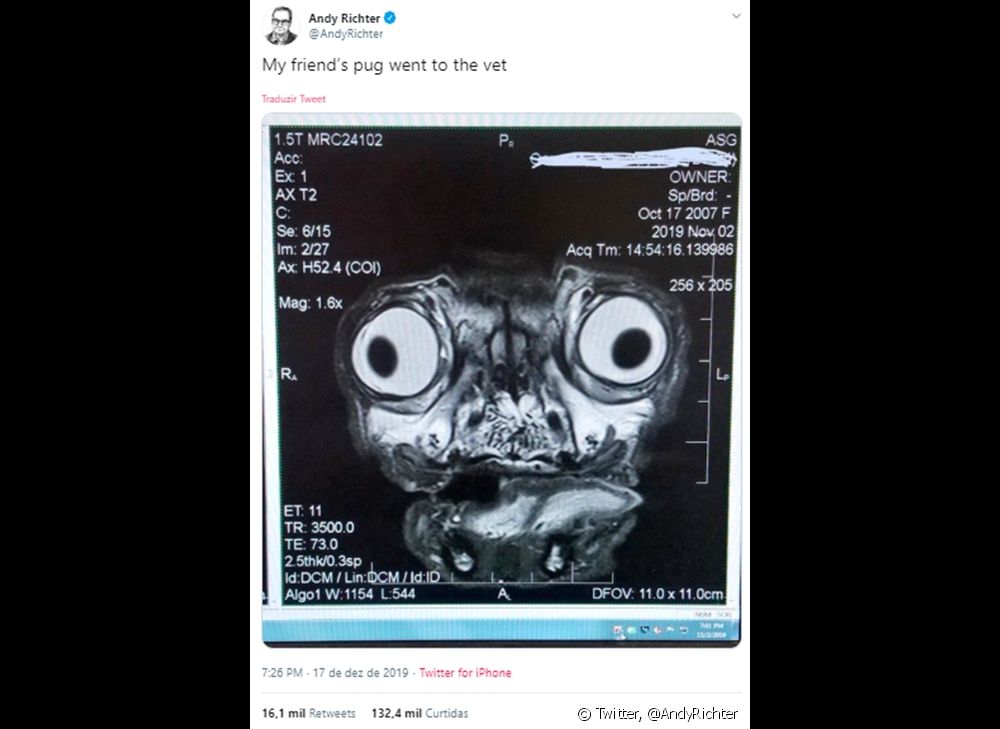Pug X-ray: the most common health problems the breed can have

Table of contents
Like everything that goes out of the ordinary on social media, recently the MRI image of a Pug went viral on Twitter. Because of the brachycephalic structure of the animal's face, the image looked different than expected and surprised many people. But it's not just in imaging tests that animals of this breed are "different": the Pug dog is prone to a number of health problems due toIf you have one of these dogs, you should be aware of some precautions to prevent more serious situations. For you to understand better, we have listed the most common health problems in Pug breed animals. Take a look!
See_also: Crying dog: what to do to calm him down?
The Pug, like other brachycephalic animals, is prone to respiratory problems
The Pug's facial structure is one of the main reasons for the breed's tendency to develop respiratory problems. With their flattened snout, soft palate and narrower than normal trachea and nostrils, they already have difficulty breathing naturally. That's why, most of the time, these animals appear breathless. In addition to being more affected by diseasesInfectious diseases such as canine influenza, they also become easily short of breath: heavy exercise and exposure to extreme heat, for example, are not recommended for these animals because of this. In many cases, these activities that seem common and simple to other dogs can be the cause of death for a Pug puppy, adult or elderly.
Pug obesity may be a consequence of their lifestyle
The combination of a very large appetite, the need to avoid heavy exercise and the lack of disposition of the Pug form a combo that results in the high rate of obesity in this breed of animals. Even the Pug puppy likes to eat more than normal and, therefore, it is up to you to control and limit the amount of food he eats. Ideally, the animal should have a diet developed by the veterinarian thatdetermine how much food he can eat, or even indicate a specific food with fewer calories and fats to avoid the problem. Light walks should also be part of the Pug's daily life: frequently, they help to avoid sedentary lifestyles and, consequently, obesity in a Pug dog breed.

Acne, dermatitis and other dermatological problems are also common in the Pug
In the region of the snout, which is more sensitive, the adult Pug and in other stages of life has a high probability of developing acne because of the oiliness of the skin combined with dirt from food, for example. Treatment is usually simple, but in all cases it should be indicated by the trusted veterinarian. In addition to acne, the folds of the Pug's body facilitate the infection of fungi and fungus.The ideal is to always check that the animal is very dry after bathing or playing in the water. Keep vaccination, tick medicine and dewormers up to date - combined with a balanced diet, his immune system will be stronger to deal with some problems.
Folded Pug ear: keep an eye on the inside of the region
As with other dog breeds that have their ears folded down, the Pug is more likely to develop infections caused by external agents. Fungi and bacteria proliferate in stuffy and humid environments, so the ideal is to always observe his ear and clean it between once and twice a week, according to the need determined by the veterinarian.
See_also: Urinary food: how does cat food work?The Pug can also have eye diseases as a consequence of its anatomy
Because of the shape of their head, Pugs have their eyeballs "sticking out." Because of this, the likelihood of corneal injuries and ulcers is quite high: the animal may bump into something or have an accident that damages the most exposed eyes. It is also because of this exposure that they are more prone to irritations and simpler infections. The most serious issue that his anatomy"eases" is prolapse of the eyeball, which is when the eye comes out of the socket because of a blow or trauma.

